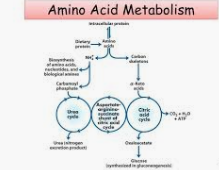Amino Acid Metabolism Multiple Choice Questions MCQs
1. Histidine is degraded to a-ketoglutarate and is described as a
A. gluco amino acid
B. glucogenic amino acid
C. ketogenic amino acid
D. keto-gluco amino acid
Answer: B
2. Which of the following amino acids is considered as both ketogenic and glucogenic?
A. Valine
B. Tryptophan
C. Lysine
D. None of these
Answer: B
3. A glucogenic amino acid is one which is degraded to
A. keto-sugars
B. either acetyl CoA or acetoacetyl CoA
C. pyruvate or citric acid cycle intermediates
D. none of the above
Answer: C
4. Which of the following is the best described glucogenic amino acid?
A. Lysine
B. Tryptophan
C. Valine
D. None of these
Answer: C
5. A person with phenylketonuria cannot convert
A. phenylalanine to tyrosine
B. phenylalanine to isoleucine
C. phenol into ketones
D. phenylalanine to lysine
Answer: A
6. Oxidative deamination is the conversion of an amino
A. group from an amino acid to a keto acid
B. acid to a carboxylic acid plus ammonia
C. acid to a keto acid plus ammonia
D. group from an amino acid to a carboxylic acid
Answer: C
7. An example of a transamination process is
A. glutamate = hexanoic acid + NH3
B. aspartate + hexanoic acid = glutamate + oxaloacetate
C. aspartate + a ketoglutarate = glutamate + oxaloacetate
D. glutamate = a-ketoglutarate + NH3
Answer: C
8. Transamination is the process where
A. carboxyl group is transferred from amino acid
B. a-amino group is removed from the amino acid
C. polymerisation of amino acid takes place
D. none of the above
Answer: B
9. The most toxic compounds is
A. tyrosine
B. phenylpyruvate
C. lysine
D. phenylalanine
Answer: B
10. A person with phenylketonuria is advised not to consume which of the following products?
A. Glycine containing foods
B. Fat containing food
C. Glucose
D. Aspartame
Answer: D

AMINO ACID METABOLISM Objective type Questions with Answers
11. Tyrosine is degraded to acetoacetyl CoA and fumarate and is described as a
A. glucogenic amino acid
B. ketogenic amino acid
C. ketogenic and glucogenic amino acid
D. keto-gluco amino acid
Answer: C
12. Transaminase enzymes are present in
A. liver
B. pancreas
C. intestine
D. none of these
Answer: A
14. An example of the oxidative deamination is
A. glutamate = hexanoic acid + NH3
B. aspartate + a-ketoglutarate = glutamate + oxaloacetate
C. glutamate = a-ketoglutarate + NH3
D. aspartate + hexanoic acid = glutamate + Oxaloacetate
Answer: C
15. In the normal breakdown of phenylalanine, it is initially degraded to
A. fumarate
B. tyrosine
C. lysine
D. phenylpuruvate
Answer: B
16. Transamination is the transfer of an amino
A. acid to a carboxylic acid plus ammonia
B. group from an amino acid to a keto acid
C. acid to a keto acid plus ammonia
D. group from an amino acid to a carboxylic acid
Answer: B
17. Lysine is degraded to acetoacetyl CoA and is described as a
A. ketogenic amino acid
B. glucogenic amino acid
C. keto-gluco amino acid
D. none of these
Answer: A
18. A ketogenic amino acid is one which degrades to
A. keto-sugars
B. either acetyl CoA or acetoacetyl CoA
C. pyruvate or citric acid cycle intermediates
D. multiple intermediates including pyruvate or citric acid cycle intermediates and acetyl CoA or acetoacetyl CoA
Answer: B
19. A best described ketogenic amino acid is
A. lysine
B. tryptophan
C. valine
D. none of these
Answer: A
20. A person suffering from phenylketonuria on consumption food containing high phenylalanine may lead to the accumulation of
A. phenylalanine
B. phenylpyruvate
C. tyrosine
D. isoleucine
Answer: B